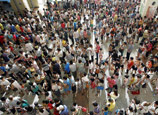
 |
| Mount Taishan(CNTV) |
Religion
Mount Taishan has a long history of popularizing religion. Buddhism was introduced to the Mount Taishan during the mid-4th century AD. In AD 351, a monk named Lang Gong first established the Lang Gong Temple and Lingyan Temple at the northern foot Mount Taishan. During the periods of the Wei, Jin, as well as the Northern and Southern dynasties, relatively large temples on Taishan Mountain included the Jade Emperor Temple, Shenbao Temple and Puzhao Temple. The Buddhist classic "Diamond Sutra" was carved during the Northern Qi Dynasty in the famous Jingshiyu area of Mount Taishan. During the Tang and Song dynasties, the Lingyan Temple was very popular among the people and Li Jifu, a top official of the Tang Dynasty, and he even called the Lingyan Temple one of the "four wonders" on earth.
There were monks living in the northern caves of Mount Taishan as early as the Warring States Period. After the Qin and Han dynasties, a large number of temples were established there. Temples such as the Wangmuchi or Qunwang Temple, Lao Jun Temple, the Longquan Taoist Temple, Bixia Temple, Houshiwu Temple and the Yuanshi Tianzun Temple still exist today. The Wangmuchi Temple established before AD 220, has the longest history among all the temples and the Bixia Temple is the most influential. Mount Taishan is the birthplace of the legend about the queen of heaven. The first Wangmuchi Temple was established as early as the Wei or Jin dynasty. The Wangmuchi Temple, also known as "Qunyu Temple" and the "abode of the immortals" in ancient times, was located to the east of Huanshan Road at the southern foot of Mount Taishan. Verses written by Cao Zhi during the Warring States Period, and written by Li Bai during the Tang Dynasty all described the Wangmuchi Temple on Mount Taishan.
Value in natural heritage
Stratum and physiognomy
Mount Taishan was formed through the evolving process of various geologic ages from the Archaeozoic period to the Cenozoic period. The great mountain systems came into being through the movement of Mount Taishan. The movement of Yanshan Mountain laid the foundation of Mount Taishan and the movement of the Himalayas created the magnificence and the general framework of Mount Taishan. In Mount Taishan, there are abundant relics of crustal movement that have research value in geological sciences around the world. The Cambrian gneiss mass, which forms the base of the tableland in northern China, has a complete stratigraphic section and is rich in well-preserved fossils. As one of the most ancient rocks in the world, the complex Mount Taishan was formed 2 billion years ago and is very important for the research on the division and comparison of the Archean stratum in eastern China and exploration into the history of the Archean period. In addition, there are typical limestone and sand-shale formations in the areas such as Zhangxia, Gushan and Chaomidian in the northwestern part of Mount Taishan. They have been regarded as the standard division between the early and middle period of the Cambrian system and the place where a few species of palaeobios were first named.


















 Wild Siberian tiger kills cattle in NE China
Wild Siberian tiger kills cattle in NE China


![]()
